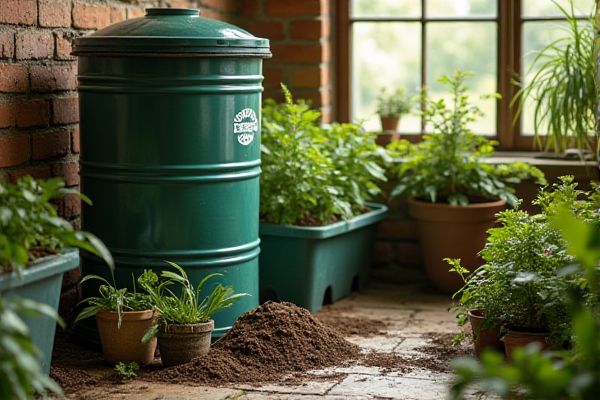
A compost tumbler offers rapid aeration and easy mixing for faster decomposition, while a worm bin provides nutrient-rich vermicompost through the natural digestion of organic waste by worms. Discover which method suits Your sustainable gardening needs by exploring the differences in our detailed comparison.
Table of Comparison
| Feature | Compost Tumbler | Worm Bin |
|---|---|---|
| Composting Method | Aerobic decomposition by turning organic waste | Vermicomposting using worms (usually Eisenia fetida) |
| Processing Time | 4-6 weeks for finished compost | 2-3 months for nutrient-rich worm castings |
| Space Requirement | Medium to large outdoor space | Compact, suitable for indoors or small areas |
| Odor Control | Limited odor if aerated properly | Minimal odor with proper maintenance |
| Best Waste Types | Vegetable scraps, garden waste, paper | Vegetable scraps, fruit peels, coffee grounds |
| Maintenance | Regular turning to aerate | Feeding worms and monitoring moisture |
| Output | Compost (humus-rich soil amendment) | Worm castings (highly nutritious organic fertilizer) |
| Cost | Moderate initial cost, low ongoing | Low initial cost, moderate care effort |
Introduction to Compost Tumblers and Worm Bins
Compost tumblers and worm bins offer efficient methods for recycling organic waste into nutrient-rich compost, enhancing soil health and reducing landfill contributions. Compost tumblers accelerate decomposition through regular rotation, using aerobic processes to break down materials quickly, while worm bins utilize vermicomposting, where worms digest organic matter producing high-quality castings. Understanding how each system works allows you to select the best option tailored to your space, waste volume, and composting goals.
How Compost Tumblers Work
Compost tumblers work by rotating a sealed drum filled with organic waste, which promotes faster decomposition through oxygen circulation and consistent mixing. This aeration accelerates the breakdown of materials while minimizing odors and pests, making it a convenient option for your backyard composting. Compared to worm bins, compost tumblers require less monitoring of moisture and temperature for efficient compost production.
How Worm Bins Operate
Worm bins operate through vermicomposting, where red wiggler worms consume organic waste and convert it into nutrient-rich castings, enhancing soil fertility. These bins maintain moisture and aeration to support worm activity and accelerate decomposition without odors commonly found in traditional composting. Worm bins are ideal for indoor use and small-scale composting, effectively breaking down food scraps like fruit and vegetable peels into high-quality compost.
Speed of Composting: Tumblers vs. Worm Bins
Compost tumblers typically accelerate decomposition by providing better aeration and easy turning, producing finished compost in 2 to 4 weeks. Worm bins rely on red wigglers to break down organic material, generally requiring 1 to 3 months for composting, depending on moisture and temperature. Tumblers are ideal for fast results, while worm bins offer nutrient-rich vermicompost but at a slower pace.
Space and Location Requirements
Compost tumblers require minimal space and are ideal for small patios or balconies, making them suitable for urban environments. Worm bins are compact and can fit indoors, such as under sinks or in closets, allowing year-round composting regardless of weather. Both systems demand careful placement to ensure proper aeration and temperature control for efficient decomposition.
Maintenance and Upkeep Comparison
Compost tumblers require regular manual turning to ensure aeration and even decomposition, typically every few days, while worm bins demand consistent moisture levels and periodic feeding to maintain worm health and activity. Compost tumblers often need less space and have lower odor risks, but they may require occasional cleaning to prevent residue buildup. Worm bins, although slower in processing organic waste, offer continuous nutrient-rich castings but require more careful monitoring of temperature and pH levels to avoid worm stress.
Types of Materials Accepted
Compost tumblers accept a wide range of organic materials including fruit and vegetable scraps, coffee grounds, yard waste, and small amounts of paper products, optimizing aeration through regular turning. Worm bins specifically process kitchen scraps such as fruit and vegetable peels, coffee grounds, and crushed eggshells, but exclude meat, dairy, and oily foods to maintain worm health. Both methods effectively recycle organic waste but require adherence to accepted material types for efficient decomposition and odor control.
Compost Quality and Nutrient Content
Compost tumblers typically produce nutrient-rich, well-aerated compost with balanced carbon-to-nitrogen ratios, ideal for enhancing soil fertility. Worm bins generate vermicompost, which is highly potent in microbial activity and contains abundant enzymes and plant growth hormones, resulting in superior nutrient bioavailability. Both methods improve soil health, but vermicompost from worm bins often offers higher concentrations of nitrogen, phosphorus, and potassium essential for plant growth.
Cost and Initial Investment
Compost tumblers typically require a higher initial investment, ranging from $70 to $200, due to their durable plastic or metal construction and ease of use. Worm bins are generally more affordable, with starter kits costing between $30 and $80, but may require ongoing maintenance and worm care expenses. Choosing between the two depends on your budget and how much effort you're willing to invest in managing your compost system.
Choosing the Right System for Your Needs
Choosing the right compost system depends on your available space, time commitment, and organic waste type. A compost tumbler offers faster decomposition and easy turning, ideal for those wanting quick results with minimal effort. Your worm bin is perfect for small spaces and produces nutrient-rich castings but requires more regular maintenance and care for the worms.
 homyna.com
homyna.com